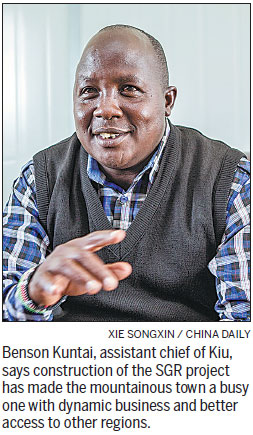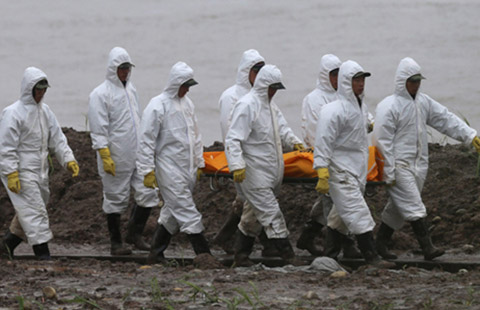
Chinese builder of Mombasa-Nairobi line changes lives by boosting incomes, training workers, building roads and digging wells
Completion of the Mombasa-Nairobi Standard Gauge Railway is still a year and a half away, but changes have already taken place along the line during construction.
The project employs many people from nearby communities, and the gathering of large numbers of construction workers has given a boost to small businesses, which also employ a lot of people.
|
New brick houses have been replacing old mud houses in Kiu. Construction of the Mombasa-Nairobi Standard Gauge Railway has benefited locals by bringing more job opportunities and more cash to spend. Xie Songxin / China Daily |
The $3.8 billion project, built by China Road and Bridge Corp, is the country's largest-ever infrastructure project. Running between major regional port Mombasa and Nairobi, which is a regional commercial hub and Kenya's capital, the track is meant to supplant a railway built by the British in the early 20th century. It aims to boost regional trade and cut transport costs.
But to the people who live in the vicinity of the track, the SGR's effect has been more immediate. It has greatly increased incomes directly and indirectly, changing lives. Many new houses are also being built.
Real estate in the area of the project has risen, with the price of some land near the line tripling.
One of the towns that has been seeing changes is Kiu. Located in a mountainous area more than 15 kilometers from Mombasa Road, which links Nairobi and Mombasa, the drought-troubled town used to be full of unemployed people because of a lack of job opportunities.
Benson Kuntai, assistant chief of Kiu, says the new railroad has changed the town into a busy one with dynamic businesses and better access to other regions.
"Before CRBC came, most people were herders, raising animals; the others were peasants and farmers (doing) small scale farming. Some worked at the quarry. These were the main ways to earn a living," he says.
The few people who were strong enough to work at the sandpit were the only group who could make a decent living, he says. "There is no amount that people say they are sure to get."
Now, things have changed. "Nobody gets less than 20,000 Kenyan shillings ($206) a month. Everybody must make more than 25,000 (shillings a month)," says Jonathan Ole Patita, a security officer for CRBC in Kiu.
Kuntai adds: "Nobody is now hanging idle. Everybody now gets jobs." The arrival of workers from other regions has created "very good business" for shops, restaurants and clothing shops, and also has pushed the cost of renting a single room from 400 shillings a month to between 2,000 and 2,500 shillings.
With more income, the 3,500 residents of the town have been busy making changes to their lives and the town.
People are changing their "mud houses with mud walls and floors" into "brick, and big ones" with fences. "If you walk along this corridor you will see many new houses are being built," says Kuntai.
While railroad construction money poured into the area won't last, there are changes that will.

One such change is the ongoing construction of the road that connects Kiu and Ulu in Kajiado, national broadcaster KBC reported. The crucial but previously impassable road serves a huge population in the area but was barely usable due to gullies caused by floods as a result of the area's erratic climate. CRBC has taken up construction of the 8-kilometer stretch that will cost the company an estimated 10 million shillings.
"The construction of this road is a big relief for thousands of people in this area. It will link pastoralists to markets, while at the same time easing general transport in the area. It will completely open up this area," Jonathan Koinanke, area chief of Erankau sub-location of Kajiado East, tells KBC.
CRBC has also drilled wells to relieve the drought-stricken town, residents say.
"There were few wells and they are at a distance. Since CRBC came, they have brought water closer," Kuntai says.
Additional, less-visible changes have been affecting people's lives. Before CRBC arrived in August, having a bank card was unusual in the town, and only those who held public positions such as teachers and police officers had them. But now "almost everybody has one", Patita says. He says the company asked the bank to come to the village to help people open accounts.
The town's crime rate has been very low since CRBC arrived, and children who couldn't afford to go to school before are attending, he adds.
Patita says the training provided by CRBC to locals could help many villagers earn a living after they go. "We are happy, and we are learning day by day rather than just make a living. Before, we depended on animals, but during these three years, we are going to change our lives."
The railway construction also has brought many changes to Mtito Andei, a town at the midway point of the Mombasa Road. Workers and people seeking business opportunities have poured into the town, increasing the population from 4,000 to 15,000 after section three of the SGR project started construction there, local officials say.
The crime rate has gone down with more people employed, many of whom have seen their income double. Small businesses serving workers have boomed.
Officials said that with construction on the rise, more hardware stores have been opened. People from other areas have bought land near the station, raising the price in some cases by more than double.
There also are expectations of more changes with a main station on the SGR line planned for the town. Tourists, many of whom come to visit two nearby parks, are expected to use the train, creating more business opportunities.
There are two national parks near Mtito Andei - Tsavo East National Park and Tsavo West National Park - that boast a large number of tourists who come for one of the most evocative images of Africa, the sight of dust-red elephants wallowing, rolling and spraying each other in the midnight blue waters of the palm-shaded Galana River.
Separated by Mombasa Road, the two parks form one of the largest national parks in the world.
However, people in Mtito Andei have gotten little direct benefit from the two parks because tourists come all the way from Nairobi by safari vehicles to the parks and stay in hotels within the parks. They consume almost nothing in the town.
Officials say trains often are more popular with tourists than cars or planes, so if tourists come to Mtito Andei by rail, they will be more likely to spend money there. Tourists can create demand for restaurants and entertainment, they say.
Officials say the train station gives them hope of seeing the town grow into a city one day.
houliqiang@chinadaily.com.cn
(China Daily Africa Weekly 06/05/2015 page8)








